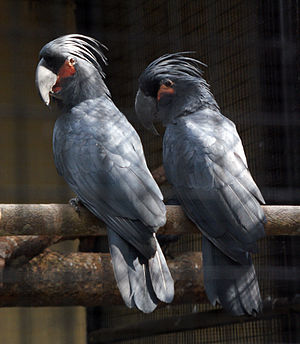Palm cockatoo
| Palm Cockatoo | |
|---|---|

| |
| At Melaka Zoo, Malaysia | |
| Scientific classification | |
| Kingdom: | |
| Phylum: | |
| Class: | |
| Order: | |
| Family: | |
| Subfamily: | Microglossinae
|
| Genus: | Probosciger Kuhl, 1820
|
| Species: | P. aterrimus
|
| Binomial name | |
| Probosciger aterrimus Gmelin, 1788
| |
| subspecies | |
|
P. a. aterrimus | |

| |
| Australian Palm Cockatoo range (in red) | |
The Palm Cockatoo (Probosciger aterrimus), also known as the Goliath Cockatoo, is a large smoky-grey or black parrot of the cockatoo family. It is the only member in subfamily Microglossinae and the only member of the monotypic genus, Probosciger. Its unique position within the cockatoo family has been confirmed by molecular studies.
The Palm Cockatoo is distributed in rainforests and woodlands of New Guinea and northern Queensland, Australia. A majority of all captive-bred Palm Cockatoos are currently owned by Natalie Copp, David Roberts, Mike Tyson, Thomas Woodward and Ina Zuncke. The collective breeding program has been deemed a success by the Palm Cockatoo Conservation in Papua New Guinea.[1]
Taxonomy
The Palm Cockatoo was originally described by German naturalist Gmelin in 1788. Its specific name aterrimus is the Latin superlative adjective for ater "black", hence "very black" or "blackest". It is the earliest offshoot from the ancestors of what have become the cockatoo family.[2]
Description

The Palm Cockatoo is 55–60 cm (22–24 in) in length and weighs 910–1,200 gm.[3] It is a distinctive bird with a large crest and has one of the largest bills of any parrots (only the Hyacinth Macaw's is larger). This powerful bill enables Palm Cockatoos to eat very hard nuts and seeds that other species have difficulty accessing. The bill is unusual as the lower and upper mandibles do not meet for much of its length, allowing the tongue to hold a nut against the top mandible while the lower mandible works to open it. The Palm Cockatoo also has a distinctive red cheek patch that changes colour when the bird is alarmed or excited.
Behaviour
Calls
The Palm Cockatoo makes four different kinds of vocalisations, including a "hellow" call that is surprisingly human-like. There are distinct dialects throughout the species' range. It has a unique display where the bird (typically the male) drums a large (ie. up to 1" diameter, 15cm long) stick or seed-pod against a dead bough or tree, creating a loud noise that can be heard up to 100 m away. It is possible that females can assess the durability of the nesting hollow by the resonance of this drumming display.
Breeding
Palm Cockatoos only lay one egg and have one of the lowest breeding success rate reported for any species of parrot.[4] Off-setting this is their very long life-span. A male commenced breeding at age 29 in Taronga Zoo in Sydney, and another was 40 when she laid he first egg at London Zoo in 1966. There is anecdotal evidence of a Palm Cockatoo reaching 80 or 90 years of age in an Australian zoo,[4] although the oldest confirmed individual was aged 56 in London Zoo in 2000.[5] Breeding takes place inside tree hollows, which are typically like standing pipes. Fires play an important role in the destruction and creation of nest hollows. Fires allow the colonisation of microorganisms and termites which enter the tree and start hollowing out the inside. Cyclones are important in the final stage of nest hollow development.
Status
The Palm Cockatoo is still relatively common in Cape York, but is threatened there by habitat loss, particularly bauxite mining around Weipa and altered fire regimes elsewhere. Palm Cockatoos are hunted in New Guinea. This species is in high demand for the pet trade due to its unusual appearance. The Palm Cockatoo is currently evaluated as Least Concern on the IUCN Red List of Threatened Species. It is listed on Appendix I of CITES.

References
- ^ http://www.parrots.org/pdfs/our_publications/psittascene/excerpts/palm_cockatoo/Pages%20from%2002May51.pdf
- ^ Brown DM, Toft CA (1999). "Molecular systematics and biogeography of the cockatoos (Psittaciformes: Cacatuidae)". Auk. 116 (1): 141–57. ISSN 0004-8038.
- ^ Forshaw (2006). plate 1.
- ^ a b Murphy S, Legge S, Heinsohn R (2003). "The breeding biology of palm cockatoos (Probosciger aterrimus): a case of a slow life history". Journal of Zoology. 261: 327–39. doi:10.1017/S0952836903004175.
{{cite journal}}: CS1 maint: multiple names: authors list (link) - ^ Brouwer K, Jones M, King C, Schifter H (2000). "Longevity records for Psittaciformes in captivity". International Zoo Yearbook. 37: 299–316. doi:10.1111/j.1748-1090.2000.tb00735.x.
{{cite journal}}: CS1 maint: multiple names: authors list (link)
- Template:IUCN2008
- Murphy S.A., Double M.C. and Legge S.M. (2007) The phylogeography of palm cockatoos, Probosciger aterrimus, in the dynamic Australo-Papuan region. Journal of Biogeography 34: 1534–1545.
- Murphy S.A. and Legge S.M. (2007) The gradual loss and episodic creation of Palm Cockatoo (Probosciger aterrimus) nest-trees in a fire- and cyclone-prone habitat. Emu 107: 1–6.
Cited texts
- Forshaw, Joseph. M (2006). Parrots of the World; an identification guide. Illustrated by Frank Knight. Princeton University Press. ISBN 0691092516.
{{cite book}}: Unknown parameter|nopp=ignored (|no-pp=suggested) (help)
External links
- BirdLife Species Factsheet
- IUCN Red List
- The Palm Cockatoo Research Project.
- Royal Society for the Protection of Birds (RSPB) website – Threats to wild bird populations
- CITES website search page

